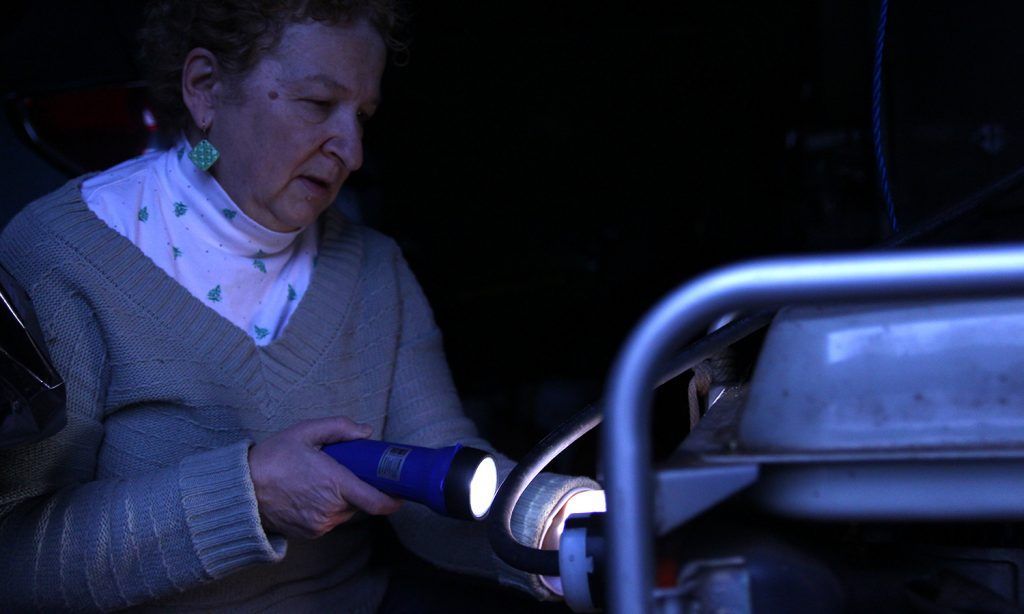
TROUT RUN – The lights flicker and dissolve into darkness. Ann Swift isn’t surprised. At her home near Powy’s Curve, outside of Trout Run, power outages are common.
This one, during the afternoon of Nov. 15, 2020, is the 13th so far this year.
Swift trudges outside to her garage to start the generator. She props open the door to the garage, reaches above her to the handle of a long rope attached to a pulley, which cranks the generator. She pulls it over and over until, finally, the machine rumbles to life.
For seven more hours, she relies on the generator until the electricity is restored. That length of time to be without power also is all too common, she says.
The power company in the Trout Run region is Penelec, one of the state’s largest power suppliers, and is owned by First Energy, which provides service to much of Pennsylvania as well as portions of West Virginia, Ohio and New Jersey.
Penelec services 17,600 square miles with 528,000 customers. In 2019, the company experienced over 995,000 customer interruptions and 146.1 million customer minutes interrupted. A state report also shows that outages have increased each year since 2016.
According to the 2019 Pennsylvania Electric Reliability Report, published by the Pennsylvania Utility Commission (PUC), Penelec’s benchmark reliability is reported as “inconsistent and frequently out of control.”
But what does this mean? For many of the small community’s residents, the poor rating offers little comfort because each year nothing seems to improve, in fact most recently, the problem has gotten worse, Swift said.
According to the report, almost 70% of the interrupted customer minutes are caused by equipment failure or trees on the lines.
On Halloween 2019, the power along Powy’s Curve went out for two days and the cause was attributed to a tree that fell on a transformer. In 2020, the region’s power has gone out more than 10 times, and eight of those outages were in the two months shortly after the state shut down due to COVID-19, according to Swift.
Each time the power goes out, it stays out for an average of eight hours.
Judy Rook lives a few miles north of Powy’s Curve, near the end of Penelec’s service line. She and her husband have lived in the region for 50 years and, like many others, their heat depends on electricity.
“If the power goes out, we huddle around the stove,” she said.
While most residents in the area have generators, Carol Prentiss’s entire home runs on electricity and she doesn’t own a generator. When the power goes out, she must go to a friend’s home, or that of one of her kids, who live in Williamsport.
A 44-year resident of the small community, Prentiss says the power outages have now become so frequent she is thinking of moving.
“We heard excuses that there are many trees in our area, but the other electric companies also have trees and the customers’ lights don’t go out,” Prentiss said. “We are in need of good service and it is sorely lacking.”
Rook, Swift and Rose-Marie Gross gathered at Gross’s home, also on Upper Powy’s Road, in August to talk about their community’s power issues. It’s a popular topic in the area, and one that seems to have few solutions.
While they acknowledge that outages are to be expected, especially in rural areas, the long-time residents hope these long gaps in service are not normal for everyone.
Gross works from home and when an outage occurs she takes the day off work.
Standards of service
Over the years, a petition made the rounds among the residents, calls to local representatives were made and complaints were sent to the company.
But one question keeps coming up – If residents only have one utility option, what standard of service should they expect and who guarantees they receive that level of service?
In rural areas, regions are split up by the state and allocated to utility providers. This ensures that the entire state is given service and that isolated areas aren’t left without power. But it also means that there is no need for competition between providers and the people on Powy’s Curve have no other option to turn to.
Standards of service for power companies are managed by the Pennsylvania Utility Commission and, according to Nils Hagen-Frederiksen, press secretary for the commission. It is the commission’s job to evaluate companies and compare them against state benchmarks and the other utilities.
“Each utility is responsible for designing and maintaining their system in a safe and reliable manner,” Hagen-Frederiksen said. “When there are individual problems….. that is something we dive into deeper.”
Dense tree coverage is to blame for most of the power issues in the region, according to Penelec.
But reliable service can be difficult to expect, according to Hagen-Frederiksen, who added that dense trees, an increase in the severity of storms in the region, as well as the death of the Ash tree population, have only made it harder to keep service uninterrupted.
With the right amount of funding and resources any utility could offer perfect service, he added, but this would drive the cost of electricity up to an unattainable level.
“How much should an individual utility go to provide uninterrupted service,” Hagen-Frederiksen asked.
Building redundancy
Not every electric company has as serious of a problem with the trees. Sullivan County Rural Electric Cooperative, services just under 6,000 customers in Sullivan, Bradford and Lycoming counties.
According to Steve Brady, a board member with Sullivan County Rural Electric, the small customer-owned cooperative uses Penelec lines to service some of its clients, some of whom live just 10 minutes away from Powy’s Curve in Gamble Township.
To ensure that its customers see less interruption in service, Sullivan County Rural Electric has built in redundancies to the system so that when service goes out, it can be restored in minutes or an hour, rather than a couple of days.
“When one substation goes down, we have a lot of back-feeding and redundancy,” Brady said, adding that Rural Electric distributes power through Penelec and PPL. “They (Penelec) certainly don’t have the redundancy we have of two other companies.”
In August, Swift filed a complaint with the PUC in the hopes that an investigation would be launched.
She received a response detailing that her home has had three outages due to equipment failure and 11 outages due to trees. Penelec also reported that 1,900 trees were cut in the service area.
The letter went on to state, “Please note, at the informal level, the Bureau of Consumer Services has limited authority to resolve your service issue, and we have closed your informal complaint.”
According to Swift, she said she was told the issue was considered resolved and the commission wouldn’t look into it further.
Penelec did not respond to calls for comment for this article.
It’s unclear if anything will change for the residents along Powy’s Curve. Some along the road have accepted things the way they are, and now, even Swift who is not afraid to make her voice heard, has lost hope it will ever get better.




